Need 15 mandala design patterns to practice? Try essentials like petal shapes, teardrop elements, swirl patterns, and layered circles for that classic vibe. Throw in simple borders, zigzag chevrons, lotus petals, and lively leaf patterns. Spiral variations and starburst designs add awesome movement, while lacework, color gradients, and negative space crank up the drama. Freehand mandala practice keeps things loose and creative. Each pattern helps you reveal new skills—stick around, because the inspiration doesn’t stop here!
Key Takeaways
- Practice foundational shapes like petals, teardrops, and layered circles to create balanced and symmetrical mandala designs.
- Experiment with dynamic patterns such as swirls and spiral mandalas to add movement and depth.
- Use decorative borders, leaf motifs, and lacework techniques to enhance mandala edges and add intricate details.
- Incorporate starburst patterns and chevron borders for bold, eye-catching visual impact.
- Explore creative expression with freehand mandalas, combining elements and color techniques for personal and unique designs.
Petal Shapes for Mandala Foundations
Petals are like the secret superstars of mandala art. Seriously, without them, Mandala Patterns would be a lot less exciting!
When starting Mandala Designs, artists always begin with a central point, then draw petals radiating out. These petals form the foundation, kind of like bones for a skeleton, but way prettier.
Symmetry is the name of the game—each petal should match its neighbors in size and spacing, or else your Mandala Art might look like it’s had too much sugar.
You can play around with different shapes: rounded, pointed, maybe even teardrop petals for extra flair.
Practice sheets focused on petals make a huge difference, boosting confidence and skill.
Swirl Patterns for Dynamic Movement
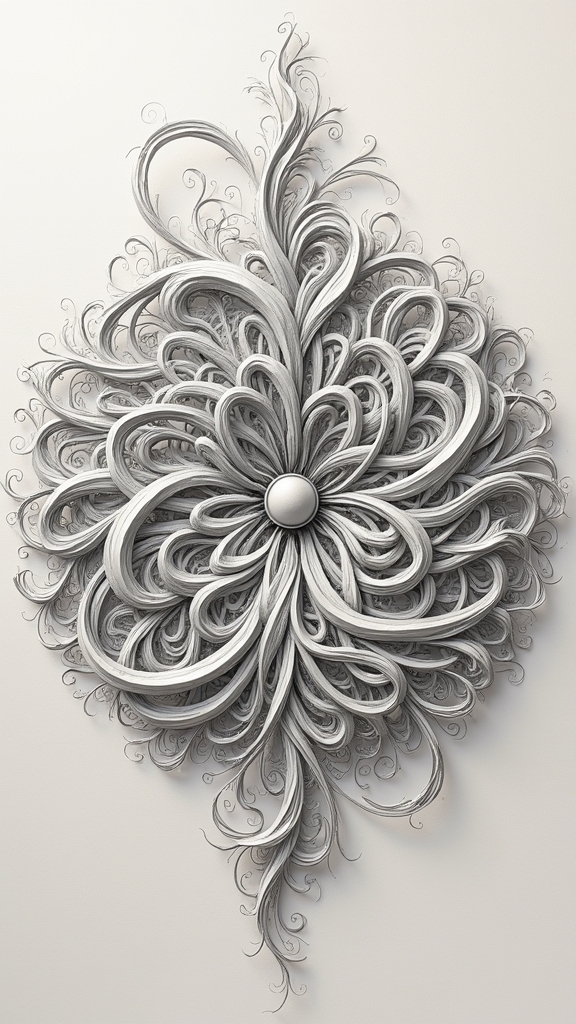
Ever wondered how mandalas seem to spin and dance right before your eyes? That’s the magic of swirl patterns! Swirls pull your eye around a Mandala, making it feel alive and energetic. Artists often use fine pens—think 0.05 or 0.1—to pack in lots of tiny, twisty details. Practicing these on Mandala Pattern Practice Sheets really boosts your hand coordination (and hey, it’s way more fun than regular handwriting drills). Swirl patterns can be mixed with all kinds of shapes, so you never get bored. They fit into petals, borders, or even the center of a full Mandala.
| Swirl Pattern Tip | Why It Works |
|---|---|
| Use a fine pen | Achieves intricate details |
| Practice on sheets | Builds hand coordination |
| Combine with other shapes | Endless creative combos |
| Try in different sections | Adds movement throughout Mandala |
Teardrop Elements for Elegant Detailing
Teardrop motifs are like little drops of magic that can totally change the mood of a mandala, making it look graceful and full of life.
Artists often use these shapes to dress up borders, sneaking them in between other patterns for that extra wow factor.
If you’ve ever wanted your mandala to look elegant but still playful, experimenting with teardrop elements might just be the trick.
Creating Teardrop Motifs
A wave of excitement often sweeps over artists when it’s time to add those elegant, flowing details to a mandala—cue the teardrop motif. Teardrop shapes are like the secret ingredient for making designs pop with elegance and energy.
The trick is to start each teardrop from a central point and stretch it out, letting the pointy end show off the direction you want to highlight. Don’t be afraid to play around! Try different teardrop variations—big, small, skinny, or chubby.
Experiment with teardrop orientations, flipping and turning them to build movement and rhythm. For even more flair, explore teardrop combinations, connecting them with circles or swirls.
Practicing these on a sheet first? Totally worth it for building muscle memory—and confidence!
Enhancing Borders With Teardrops
Once those teardrop motifs start flowing, artists quickly notice how much personality these shapes can bring—not just in the center, but along the very edges of a mandala.
Borders suddenly come alive with teardrop spacing techniques, making each section pop or blend smoothly, depending on the look you want.
Want to add drama? Try teardrop orientation variations—flip some shapes sideways or upside down. The effect is like a dance party on the edge of your mandala!
And don’t forget wild teardrop color combinations. Try shading a row in ombré blues, or go totally wild with rainbow gradients.
All these tricks help guide your viewer’s eye and make the border feel anything but boring. It’s elegance with a splash of fun!
Layered Circles for Balanced Spacing
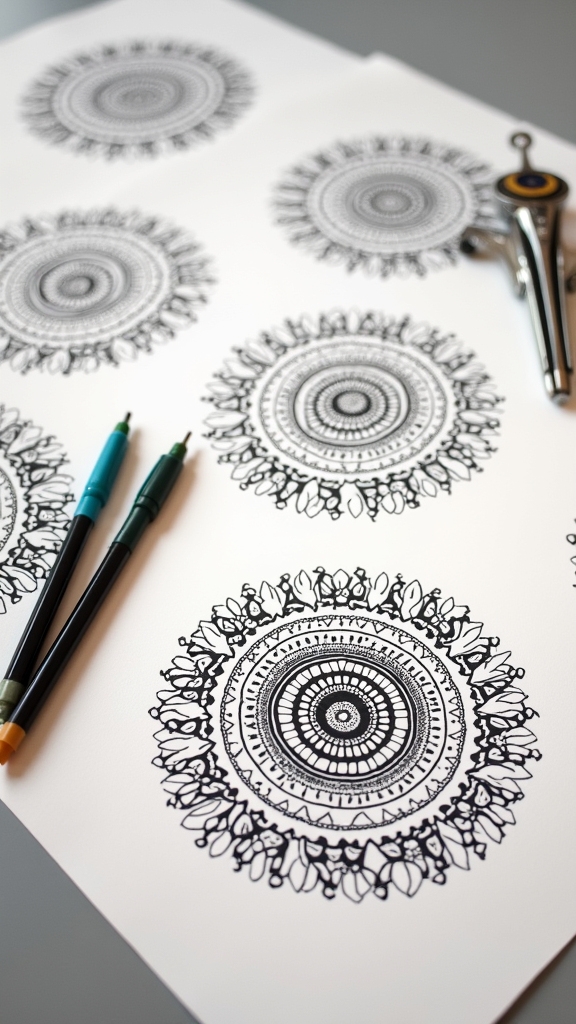
Even though mandalas can look super complicated, creating balanced spacing is surprisingly easy with layered circles. Start with a small circle in the center, and then add more circles around it, making each one a little bigger.
This is where circle spacing techniques really shine—keep the space between each circle equal, and suddenly, your design feels calm and organized. Using tools like a compass or circular templates is a total game-changer for mandala symmetry exploration.
Plus, playing with pen sizes for the outlines—thicker for the big circles, thinner for the tiny ones—makes your layers pop. Layered design principles help everything fit together, like a puzzle.
Try experimenting with different circle sizes and spacing to see what looks most awesome to you!
Simple Mandala Borders to Frame Your Art

Simple mandala borders are like the cool frames that make your artwork pop, adding just the right touch of style and organization.
With easy border pattern ideas, artists can quickly switch up the look of their mandalas—kind of like changing outfits for a special event!
Borders not only make the art stand out, but they also let you experiment and show off your own creative flair.
Easy Border Pattern Ideas
Borders can turn ordinary mandala art into something that really pops, kind of like adding a cool frame to your favorite photo.
For anyone searching for border design inspiration, the Easy Mandala Border Patterns collection offers 210 simple designs that fit perfectly on A4 paper.
Each border is super clear and precise, so when you print them out at 100% scale, they look crisp and awesome.
Artists can use these for mandala framing techniques, making their artwork stand out without much effort.
The collection even comes with traceable practice sheets—yes, you can actually practice before going for the real deal!
These designs are not just for mandalas; creative pattern applications could include decorating journal pages or posters.
Grab them on WhatsApp for ₹750 or $12.
Enhancing Artwork With Borders
A splash of creativity can totally transform a drawing, and that’s where mandala borders come in—they’re like the secret sauce that frames your art and makes the main design pop. With over 210 awesome border design techniques to try, artists can pick framing styles that fit any vibe, from chill to super bold. Each border helps give the artwork more visual emphasis, making the center look even cooler. Plus, these patterns are made for A4 paper, so there’s no guesswork—just print and go! Practicing with these borders isn’t just pretty, it’s also a sneaky way to boost your drawing skills.
| Excitement | Focus | Pride |
|---|---|---|
| Wow factor! | Centered art! | I made this! |
| So many! | Eye-catching! | Looks pro! |
| Fun lines! | Framed magic! | Nailed it! |
| Creative! | Standout work! | Show it off! |
Geometric Grids for Structured Designs
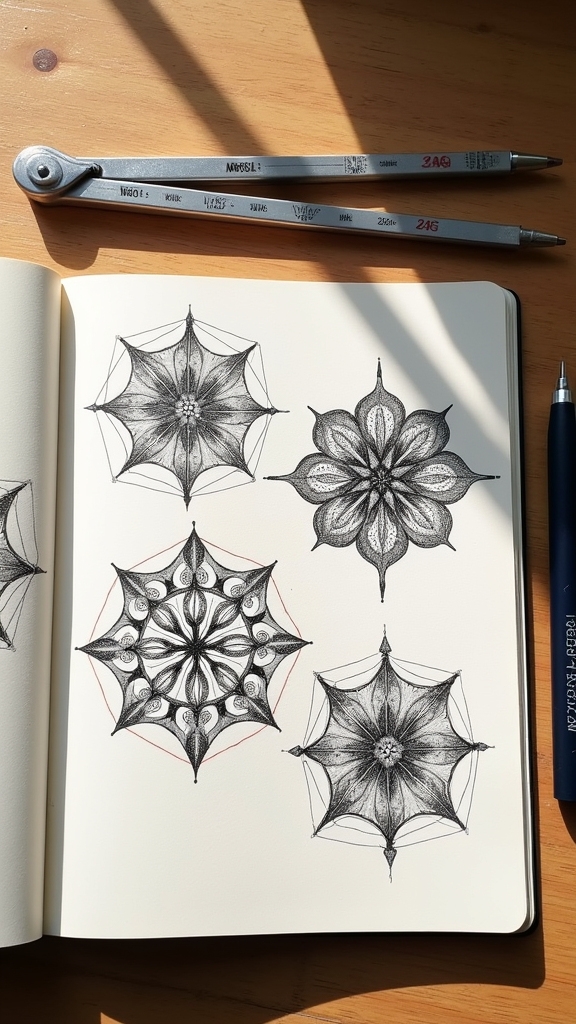
Many artists find that geometric grids are like secret weapons when it comes to creating mandala designs with eye-popping symmetry.
These grids aren’t just lines on paper—they’re roadmaps for awesome geometric symmetry techniques. With a grid, tricky patterns suddenly seem way less intimidating, and artists can really flex their grid based creativity. It’s like having training wheels, but way cooler and more mathematical.
Plus, experimenting with shapes exploration methods—mixing circles, triangles, and squares—can lead to all sorts of wild, balanced designs.
- Geometric grids help break down big, complex patterns into bite-sized chunks, making them easier to draw.
- Practicing on pre-drawn grids sharpens spatial skills and muscle memory for future masterpieces.
- Using different shapes within the grid pushes creativity and makes every mandala unique.
Dot Mandalas for Meditative Practice
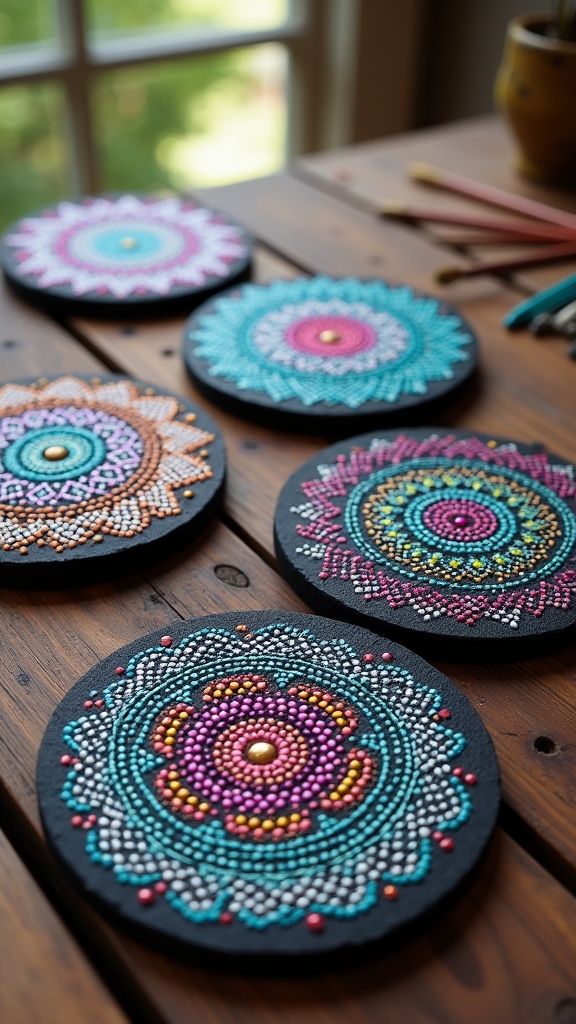
Dots might look tiny and simple, but in the world of mandalas, they’re total game-changers. Dot Mandalas are all about using careful dot placement techniques to build amazing patterns, one dot at a time.
It’s like pixel art meets mindful art—your brain dials down the stress while your hands do something fun. Creating these patterns isn’t just about making pretty designs; it’s a form of creative meditation. Each dot is placed with intention, helping artists focus and relax.
The best part? You can use dotting pens, wooden dowels, or even the end of a paintbrush, and try this on paper, canvas, or stones. Plus, dot mandalas are perfect for all skill levels, and they help fine-tune your motor skills too!
Floral Motifs for Organic Flow
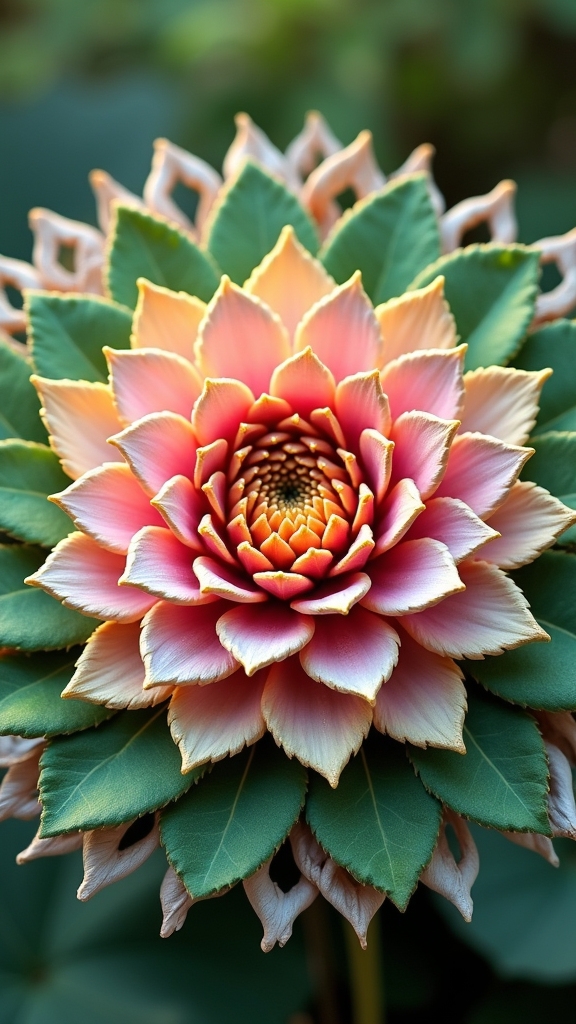
After mastering the magic of dot mandalas, things get even more interesting when floral motifs enter the scene. Suddenly, your mandala bursts with life, as petals, vines, and leaves swirl together in a dance of organic shapes.
Flower symbolism creeps in too—each blossom can mean something special, like peace, growth, or love. Adding these elements brings new depth and helps create that perfect mandala balance everyone craves.
- Drawing different flowers, like daisies, roses, and lotus petals, adds visual excitement and variety.
- Mixing in leaves and curling vines gives extra texture, making your mandala feel more alive.
- Layering and arranging floral motifs in creative ways lets you show off your personal style and experiment with unique patterns.
Who knew flowers could be so powerful?
Starburst Patterns for Visual Impact
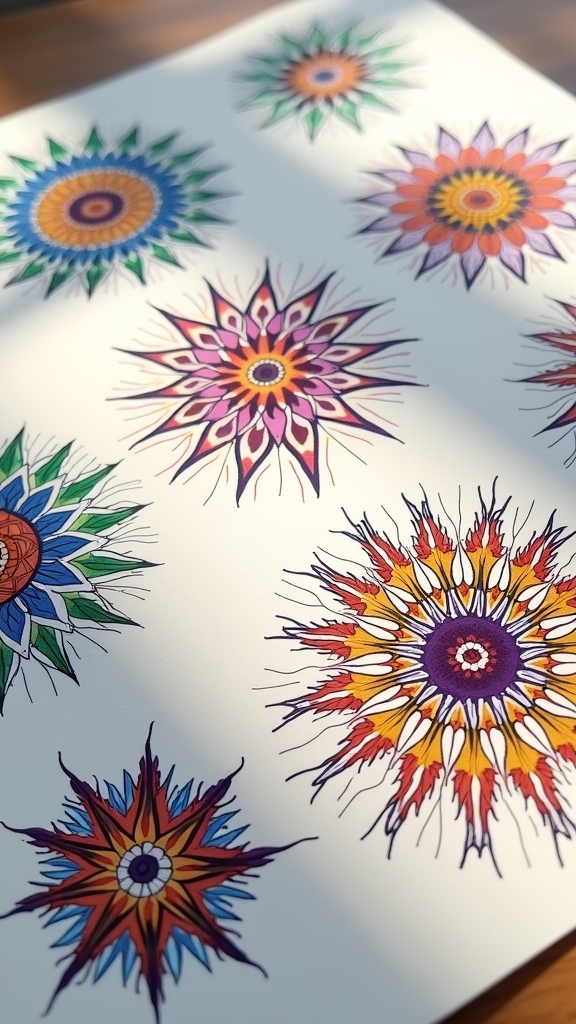
Starbursts practically explode with energy in mandala designs, stealing the spotlight with their bold, radiating lines. These patterns are like fireworks on paper—each line shoots out from a central point, grabbing attention and pulling your eyes to the heart of the mandala.
Starburst techniques often mix sharp angles with softer curves, balancing wild energy and calm harmony. Symmetry in design is key here; it keeps things from looking like a spaghetti accident and instead makes the design pop.
Want more drama? Try color gradient experimentation! Shading from bright to dark or mixing colors can make those lines look like they’re actually glowing.
Practice sheets for starburst patterns help build muscle memory, so soon your starbursts will shine with confidence.
Ornate Lacework for Intricate Effects
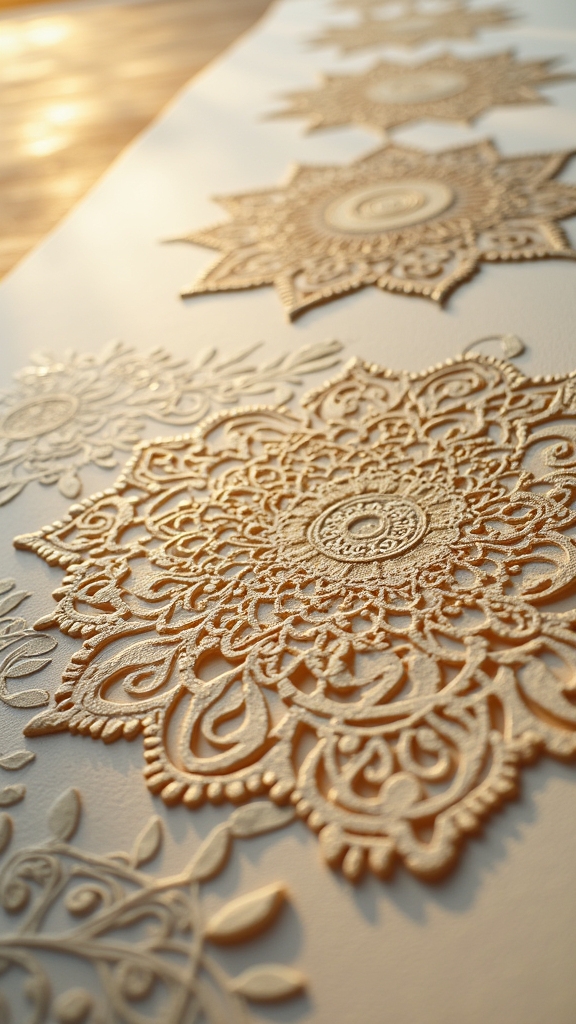
Lacework in mandala designs is like the secret ingredient that turns something pretty into something jaw-dropping. The magic happens when artists use lacework techniques—tiny, delicate lines that bring a level of detail most people wouldn’t expect.
With a fine-tipped pen, like a 0.1, every swirl or teardrop shape pops out, making the design look almost impossible to draw. But here’s the best part: practicing these patterns isn’t just about showing off your skills. It actually helps with muscle memory and can even be super relaxing.
Think of it as artistic relaxation, where your mind unwinds as your hand finds its rhythm. For a truly striking lacework mandala, try focusing on:
- Pattern precision with fine pens
- Layered borders for extra depth
- Swirling, organic shapes
Repeating Leaf Patterns for Harmony
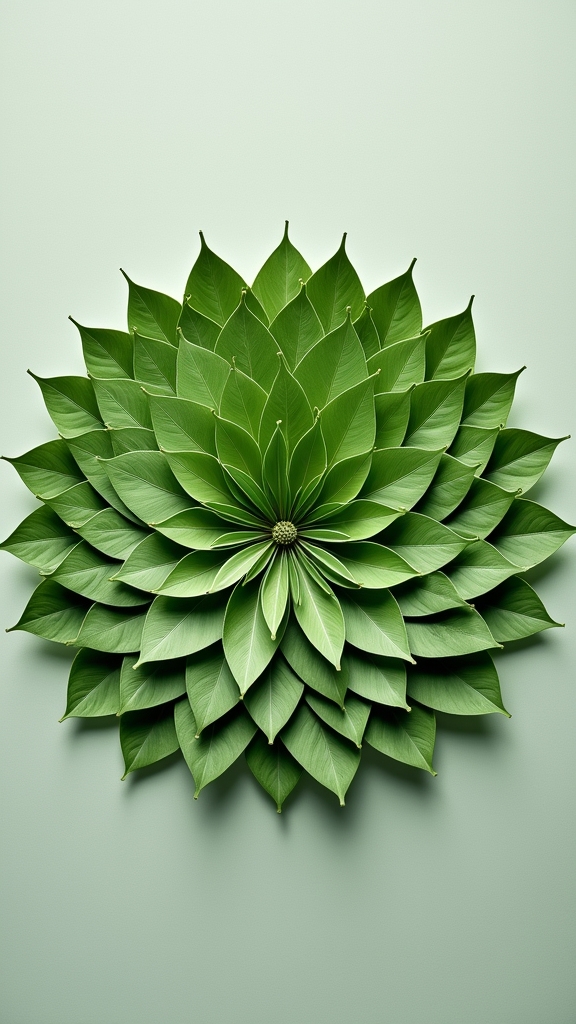
Harmony practically dances across the page when repeating leaf patterns show up in a mandala. These nature inspired designs aren’t just pretty—they’re calming, too, almost like your brain is taking a deep breath.
Repeating leaf shapes, whether tiny and dainty or bold and broad, create a peaceful rhythm that’s super satisfying to color. Artists often use mindfulness techniques while working on these patterns, focusing on each stroke and shade, letting worries drift away.
Choosing colors isn’t random, either—leaf color symbolism matters! Green might mean growth, while gold could stand for hope. Using greyscale tracing sheets lets people experiment with these ideas, all while secretly improving their painting skills.
Seriously, repeating leaves are like yoga for your art muscles—flexible and relaxing.
Chevron and Zigzag Borders for Edgy Contrast
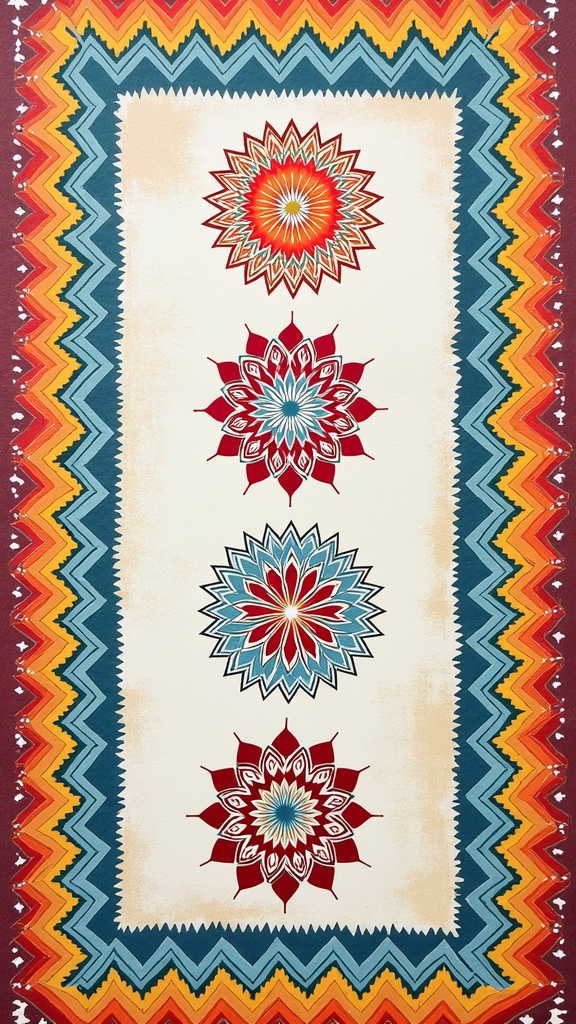
Lightning bolts for your mandala—that’s basically what chevron and zigzag borders feel like. These patterns add instant energy and punch to any design, making them the rock stars of border creativity.
Chevron patterns and zigzag designs aren’t just fun to draw—they create edgy contrast that grabs attention right away. Whether framing the center or forming their own spotlight, they know how to steal the show. Artists looking to level up can really experiment here!
- Chevron patterns and zigzag designs come alive with bold or unexpected color combos, making every border pop.
- Traceable practice sheets help artists nail the angles, so the chevrons and zigs come out crisp, not wobbly.
- Adding these borders to your mandala boosts creativity and sharpens your pattern skills—a win-win.
Lotus Petal Arrangements for Unity
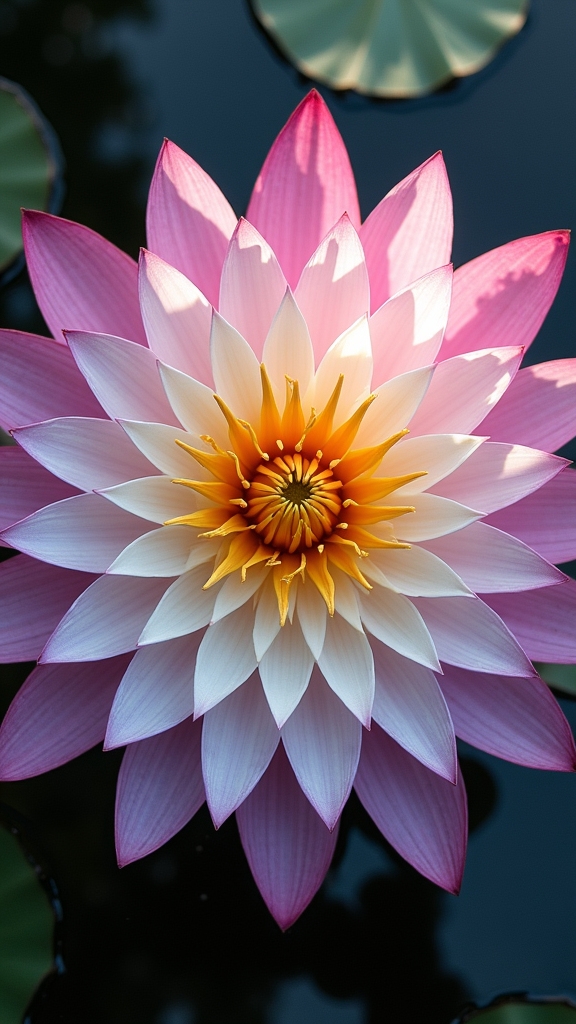
Lotus petal arrangements in mandalas are more than just pretty patterns—they stand for unity and a fresh start, like a team working together or a flower opening in the morning sun.
Artists often layer the petals in cool ways to make everything feel balanced, and choosing colors that blend or pop can really tie the whole look together.
It’s almost like the petals are having a group hug, making sure no one gets left out!
Symbolism in Lotus Petals
Circles have a way of pulling everything together, and when artists fill those circles with layers of lotus petals, something magical happens.
The lotus is more than just a pretty flower—it’s a symbol of purity and awakening, and its petals tell a story about unity and spiritual growth. When exploring lotus symbolism, each petal can stand for a different layer of consciousness, kind of like leveling up in a video game but for your mind!
The way petals are arranged isn’t random, either; there’s a real art to it. Here are some cool things to examine:
- Lotus symbolism exploration reveals deep connections to personal growth.
- Petal arrangement techniques can change the whole vibe of a mandala.
- Cultural significance analysis shows that lotus petals mean unity worldwide.
Layering for Visual Harmony
Even though it might look complicated at first, layering petals in mandala designs is actually about finding balance and pulling everything together in a way that just feels right. Petal arrangement techniques are like a secret code for unity—if you mix big and small petals and stack them neatly, your design pops with harmony. Using layering color techniques, like adding darker edges or lighter centers, makes your petals stand out even more. And don’t forget about symmetry versus asymmetry—sometimes perfect balance looks awesome, but a little chaos can be cool, too! Practicing on tracing sheets makes it easier to master these tricks. Here’s a quick guide:
| Technique | What It Adds | Pro Level Tip |
|---|---|---|
| Varying petal sizes | Depth & interest | Try odd numbers for variety |
| Layering color | 3D effect | Blend at the edges |
| Symmetry/asymmetry | Unique unity | Mix both for surprise! |
Color Choices for Unity
Sometimes, choosing just the right colors can feel like magic—suddenly, all those lotus petals snap together into something that looks totally unified and awesome.
In mandala design, color choices don’t just look cool; they actually change the whole vibe through color psychology. Lotus petals, for example, really shine when you use analogous colors, making the whole pattern flow like a chill river.
Color saturation matters, too—using lighter tints and deeper shades of your main color can pull everything together into one big, balanced masterpiece.
And don’t forget, color blending or gradients across the petals can seriously level up the unity factor.
- Use a limited color palette to keep things cohesive.
- Add gradients for smooth color blending across petals.
- Play with different saturations for depth and unity.
Spiral Mandala Variations for Depth
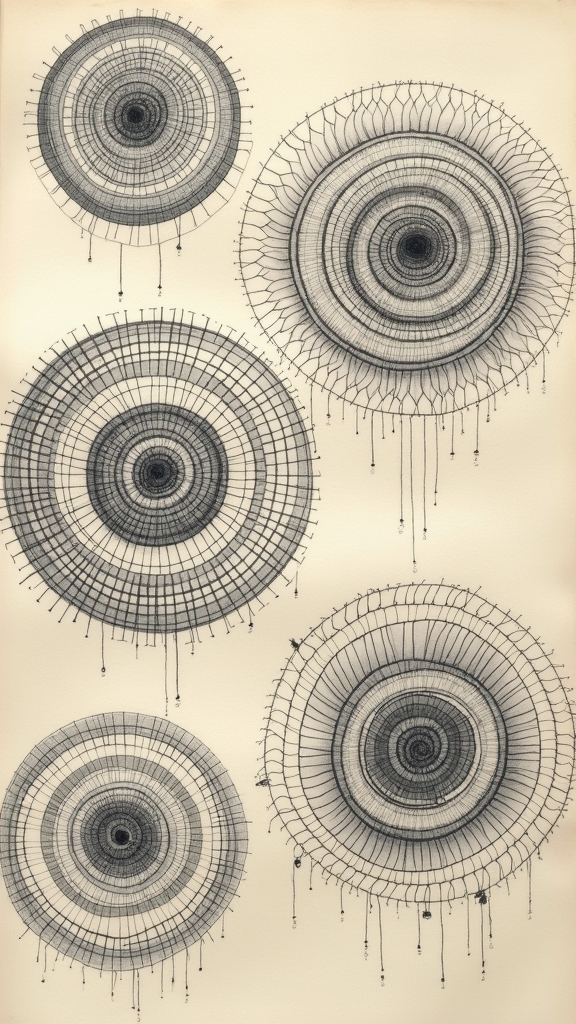
A whirl of spirals can totally transform an ordinary mandala into something with eye-catching depth and movement. Artists love using spiral exploration techniques to mix up their designs—sometimes making tight, tiny coils, other times going big and bold with wider loops. With depth illusion techniques, changing the line weight and spacing tricks the eye into seeing three dimensions, kind of like your mandala is popping off the page! And don’t forget about gradient color application; blending colors from light to dark along the spirals can make them look even deeper and more dramatic. Tools like compasses help keep those spirals looking sharp, but layering freehand or template spirals adds loads of complexity.
| Spiral Technique | Visual Effect |
|---|---|
| Varying Line Weights | Creates shadow and focus |
| Layered Spirals | Adds 3D depth and complexity |
| Gradient Coloring | Enhances movement and illusion |
Freehand Mandala Practice for Creativity
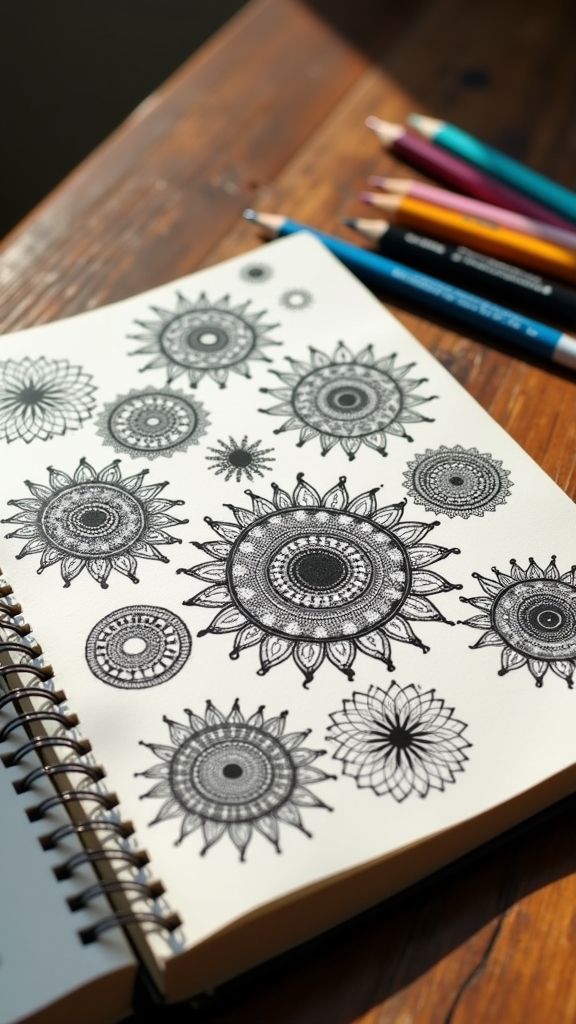
Swirling spirals might pack a punch, but there’s something magical about grabbing a pen and just letting your hand roam free. Freehand mandala practice isn’t about perfect circles or following a template—it’s about letting creative expression techniques run wild.
With no rules, artists get to immerse themselves in spontaneous design exploration, mixing swirls, petals, or anything the mind dreams up. Regular mindful drawing exercises help build muscle memory, so each time, lines feel smoother and bolder. It’s kind of like doodling in class, but with a purpose.
- Using practice sheets boosts confidence and helps master freehand patterns.
- Drawing a mix of shapes adds eye-catching complexity to every mandala.
- Freehand mandalas double as meditation, turning each session into a calming, creative adventure.
Frequently Asked Questions
How Do You Practice Mandalas?
Practicing mandalas involves using mandala drawing techniques to develop precision and creativity. This process encourages creative expression while promoting mindfulness benefits, as individuals focus on repetitive patterns, gradually progressing from simple to complex designs through regular, dedicated practice sessions.
What Are the 3 Types of Mandala?
The three types of mandala include Geometric Mandalas, characterized by intricate geometric shapes; Natural Mandalas, inspired by nature; and Cultural Mandalas, reflecting cultural significance. Each type offers unique therapeutic benefits, supporting meditation, creativity, and spiritual understanding.
Is Mandala Art Good for the Brain?
Mandala art offers notable cognitive benefits by enhancing focus and concentration, while also supporting stress reduction through mindfulness. Additionally, it encourages creative expression, stimulating both hemispheres of the brain and promoting emotional well-being and mental balance.
What Is the Rule for Creating Mandalas?
In creating mandalas, the principal rule is maintaining symmetrical balance, where each segment mirrors others around a central point. This approach fosters a sense of spiritual connection and reflects the cultural significance inherent in traditional mandala art forms.
Conclusion
Trying out these 15 mandala design patterns is like revealing a secret level in art class—there’s always something new to doodle, shade, or swirl. Whether someone loves neat circles or wild, freehand shapes, these patterns offer endless ways to get creative. Messy lines? No worries. That’s part of the fun! So grab some paper, pick a pattern, and see where those lines take you. Who knows? A masterpiece might be just a swirl away.

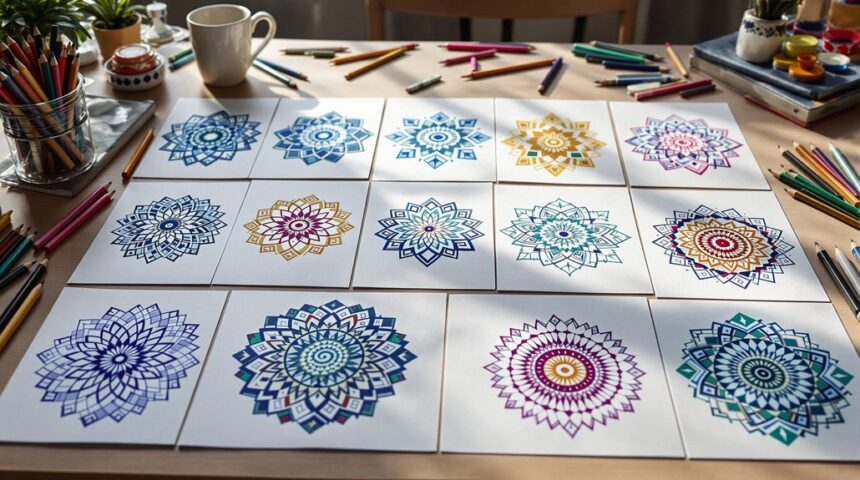
Leave a Reply